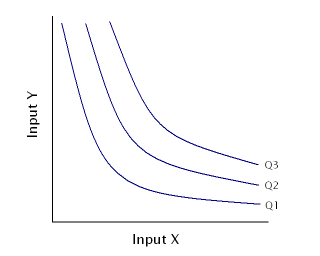Isoquant
In microeconomics and there especially in the theory of the company, an isoquant is a special type of isoline .
There are two common definitions of the term isoquant , this is either
- a) the locus of all efficient combinations of factors of production that produce the same output , or
- b) the locus of all combinations of production factors, the maximum output of which is the same.
definition
If only two factors are used in production, production functions can be represented graphically using isoquants . An isoquant is the set of all combinations of factors that produce the same maximum output level ,
- .
A production function is defined by a system of isoquants (analogous to this, indifference curves characterize a utility function ). The slope of an isoquant shows the marginal rate of substitution (short: GRS ). It can be determined by the theorem of the implicit function . In the isoquant diagram, a minimum cost combination can be seen as a tangent point of the isoquant and the isocost line .
Web links
Individual evidence
- ^ Friedrich Breyer, Microeconomics. An introduction, 5th edition, Springer 2011, p. 19.
- ↑ J ÜRGEN Eichberger : Basic Microeconomics . 2004, p. 114.








